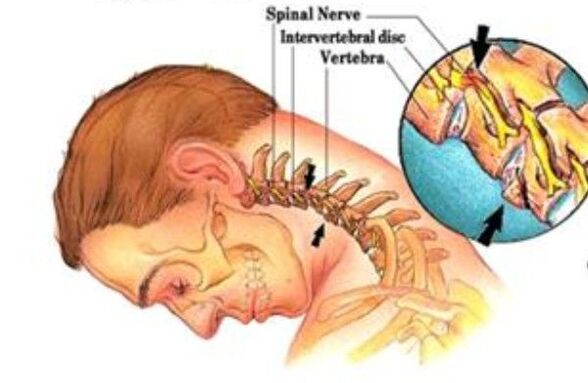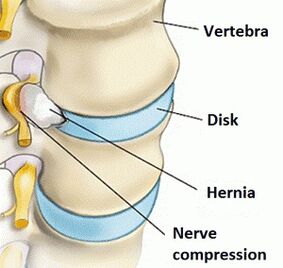
The pain in the neck is an alarming signal.Maybe it's just an overvoltage and you just need to relax and relax.But what if the pain is associated with cervical spine osteochondrosis?It is important to carefully consider symptoms and treatment, because complications can affect the most important organ - the brain.
What is cervical osteochondrosis
Cervical spine osteochondrosis is a degenerative disease of the body's bone cherry system.This leads to the destruction of cervical intervertebral discs, the growth of the bone tissue of the vertebrae, to the formation of growth on their surfaces.
The cervical spine consists of seven vertebrae, the first of which is articulated with the skull.The anatomical and functional unit of the spine is the spinal segment.This is a joint complex, because the spine column moves.The complex consists of two vertebrae, the intervertebral disc, the joint surfaces of the vertebrae (facet), nerves, ligaments and muscles.
Osteochondrosis begins with damage to the intervertebral disc and affects all surrounding tissues.Over time, the process leads to a violation of spine biomechanics as a whole.With the development of osteochondrosis, intervertebral disc hernias may form, can form nerve roots and blood vessels.
Pathological processes on the intervertebral disk occur four stages: diet, weakening of ligaments, disc damage and nerve compression.

- Stage 1.The conditions of intervertebral disc power and metabolism are violated.Due to the characteristics of the structure, the discs are consumed only during movement.Otherwise, dystrophic changes of the fabric begin: the disc is starving and dehydrated.Water loss leads to the fact that the intervertebral disc cannot perform the functions of depreciation.The load in the fibrous ring intensifies, cracks and tears appear on it.At this moment, a little pain may appear.
- Stage 2.In the second stage, the ligament apparatus of the vertebral segment occurs.The connection becomes pathologically mobile.The pathological process on the disc is aggravated, hernia (prolapse) begins - infiltrating the core of the spray through cracks in the fibrous ring.The pain becomes periodic.
- Stage 3.In addition, the intervertebral disc is completely damaged.The disc core of the disc goes beyond the fibrous ring.The resulting hernia can infringe the nerve roots.The inflammatory process develops.This is manifested by an exacerbation of pain, root syndrome with flames.
- Stage 4.In the fourth stage, defeat affects nearby fabrics.It is possible to squeeze the root artery, which leads to the lack of blood supply to the spinal cord.As a result, the column can be completely immobilized.
The first signs and the main symptoms
At the beginning of the development of cervical region osteochondrosis, discomfort, movement limitation, neck pain.Often this does not attribute importance.
Over time, the pain intensifies, becomes painful, burnt, head, neck, shoulder plates, shoulders hurt - perhaps this develops vertebral artery syndrome.The artery is squeezed or spasmodic, blood flow is disturbed.
In 1-2 stages of cervical osteochondrosis, ophthalmological problems associated with vessel spasm usually occur.Darkening in the eyes, shaking, the appearance of "flies", colorful spots in front of the eyes - all these are symptoms of osteochondrosis.
The most frequent symptoms of cervical osteochondrosis:
- Migraine, dizziness, nausea and cough.
- Hearing impairment, ear pain, face.
- Engine disorders in the hands, legs.The sensitivity of the skin on the head can be a gap.
- Hand pain.If a nerve spine is compressed, the whole area in which it sends impulses can hurt or "fall".
In addition to the above symptoms, you can distinguish three main pain syndrome, accompanying cervical spine osteochondrosis.The syndrome is a complex of symptoms.The determination of main pain syndrome is important, since the entire treatment regime is built precisely to eliminate pain.And it is impossible to eliminate it without knowing the origin.
- Myofascial syndrome- Pain in the skeletal muscles and adjacent fascia.The violation is associated with overload, where spasm, hypertonicity occur, we painful within the muscles (trigger points).
- Rook Syndrome- The pain caused by the prolonged tightening of the roots of the spinal nerves.The process of hernia formation for spine osteochondrosis leads to a pinch of the nerve fibers and the subsequent inflammatory reaction.The pain spreads along the nerve.
- Facet syndrome- Pain in the vertebrates.The vertebrae of the second cervical have joint processes, which are interconnected by the arched joints (facet).With osteochondrosis, intervertebral discs are destroyed, their height decreases, and this leads to the fact that joint capsules of the arched joints are constantly tension.This causes pain.In addition, pain increases by the end of the day, especially with a long -term forced position.
The causes of osteochondrosis in the cervical spine One of the main causes of osteochondrosis is the evolution of the spine to a high vertical load.People's ancestors walked four legs, like other mammals.They have not suffered from osteochondrosis, as in the horizontal position of the intradiscanade body by the pressure is half the vertical.From the patterns of evolution, the transition to straightening took place a short time ago, and the spine simply had no time to adapt to a high vertical load.Thus, along with straightening, a person also acquired diseases of the musculoskeletal system.
An even more vulnerable neck of a person makes his structure.The cervical department of a person consists of seven small mobile vertebrae, which are articulated by the type of children's pyramid.This design can hardly be called stable outside the rest of the rest.In addition, the muscle structure in this area is weak and the loads can be high - all makes the neck vulnerable.Any injury is full of consequences.Even though the damage was in another column, load redistribution can cause osteochondrosis.
Another factor is aging.The formation of the cartilage skeleton and tissue ends at 21 and, after that, the irreversible aging process (degeneration) begins.Cartilage foods are performed only due to diffusion and, if the intervertebral disc does not receive nutrients, it begins to collapse gradually.
In addition, the development of cervical osteochondrosis contributes to:
- Autoimmune diseases.They involve their own body cells in the pathological process of the destruction of the cartilage tissue.
- Infections, hormonal insufficiency, slowdown in metabolism - all of these circulatory disorders can also serve as factors for the development of osteochondrosis.
- A sedentary lifestyle, working conditions under which a person spends most of his time in a forced static position.
- High loads that lead to injury can lead to compression.
- Genetic defects associated with the weakness of the musculoskeletal system and the inferiority of cartilage tissue.
The vertebral spine canal in the cervical spine is very narrow, so high loads, any violation or injury can lead to compression of the spinal cord.And this is very dangerous.
In addition, a large number of nerve endings and blood vessels pass in this area.If the blood stops flowing into the brain in the proper volume, a stroke can happen.
Diagnosis
In the primary diagnosis of cervical osteochondrosis, the doctor collects the patient's history.He discovers this and how it hurts, with what intensity, with a load or rest, what time of day it hurts stronger, if the cervical spine has occurred.
During the neck examination, the doctor feels the cervical vertebrae and the muscles, lymph nodes;Evaluates the volume of movements, excludes or confirms Rooser's syndrome.
After that, a laboratory diagnosis is prescribed to exclude autoimmune diseases: a general blood test, ESR, rheumatoid factor, antigen HLA B27.
The main role in the diagnosis is given to radiography, computed tomography and magnetic resonance imaging.
- RntgenographyIt helps to evaluate the condition of bone structures, soft tissues and cartilage in the figures are not displayed.To view these structures, the contrast medium is introduced: angiography, discography, myelography.
- Computed tomography (CT).This method also uses the radiography principle, but using computer processing you can get a series of photos of longitudinal and transverse sections where you can see bones and cartilage.
- Magnetic Resonance Tomography (Magnetic Resonance).It is a "standard" in the diagnosis of pathologies, including cartilage and soft tissues.Magnetic resonance imaging gives an idea not only about the structure of organs and tissues, but also its functioning.In the case of osteochondrosis with a frequent complication, there is a hernia of the spine.Magnetic resonance imaging allows diagnosing the process of hernia formation in the early stages.
Treatment
The treatment of cervical spine osteochondrosis is reduced to conservative methods.Initially, pain syndrome is removed and then various procedures are prescribed.But in the most extreme cases, when pain does not go through more than three months and medications do not help, surgery becomes the only way out.
Non -surgical treatment methods
Osteochondrosis has reached the bone -so -old system for more than a year and therefore treatment will take time.Patience must be obtained.Conservative treatment tasks:
- Eliminate pain.
- Remove inflammation.
- Restore the roots of the spine roots.
- Strengthen muscle corset and ligaments.
Conservative treatment includes drug therapy and physical therapy.Preparations help relieve pain during exacerbation and physical therapy - to launch self -tapping processes.
During intense pain with root syndrome, the “block” called is performed: the drug is administered in the immediate immediate spine of the spinal spine of the spinal nerve.
Physiotherapeutic treatment is based on natural and artificially recreated physical factors: cold, heat, electric current, magnetic radiation, laser and others.For its reconstruction, special devices, devices and manual methods are used.
- Laser therapy- Biological activation of the regeneration processes of intervertebral discs.The body begins to self -heal.
- Plasmotherapy (PRP therapy)- Plasma injections isolated from the patient's blood.Plasma is rich in platelets, growth factors, hormones.After injection, local immunity increases, regeneration processes are launched.
- Acupuncture- Stimulation of nerve endings with special needles.It improves metabolism in affected areas, relieves pain.
- Shockwave therapy- Exposure to high frequency waves.Allows you to start natural recovery processes.
- Cinerape- Movement therapy.It can be active (exercise therapy) and passive (massage, traction).LFK strengthens the muscles of the back, traction relieves tension and pain.It is selected taking into account the individual characteristics of the patient.
- Manual Therapy and Massage- Exposure to soft tissues and joints to restore balance in the body and synchronization of processes.Return mobility and eliminate pain.
- Recording- Paste Special Emplasts on the Skin in places where it is necessary to affect the stretching and compression receptors of the muscles.It can relax and increase the tone.
During acute pain, the patient is recommended to use special neck bandages and necklaces.
The positive effect of conservative treatment is achieved in 2-3 months.If there is no result, the patient will be recommended.
Surgical Methods of Treatment of Osteochondrosis
Operation in the case of cervical osteochondrosis is an extreme measure for special indications.The operation is recommended if:
- Pain cannot be removed by therapeutic treatment for more than 3 months.
- There is a hernia of the intervertebral disc.
- Member sensitivity disappears
Post -operative rehabilitation also takes time and may include therapeutic treatment.
Cervical osteochondrosis is a complex degenerative disease.You can't treat it.Such serious violations in the musculoskeletal system can lead to disability.Pain in the neck can become chronic, osteochondrosis will spread to various parts of the spine.Opportune prevention can prevent the development of this disease.
Prevention
To maintain the health of the cervical spine, daily physical activity is required.The food of intervertebral discs occurs in motion, so it is extremely necessary.It is important that cargo are ideal and regular.
If the work is related to constant findings in a static position, periodic heating will be required.And at home, after a business day, you can lie on your back on a flat surface for some time, placing a roll under your neck.This method will help restore the cervical curve of the spine, remove muscle tension.
In the prevention of cervical osteochondrosis, the correct pose during sleep is important.If a person in the morning rises from pain in the neck, the muscles did not have time to relax and recover.
Here, an orthopedic pillow, which is individually selected for 3-5 years will help.
Do not postponed treatment
A doctor will help you choose a recovery program.It will evaluate the condition of the spine in magnetic resonance imaging, will report the probability of resorption and the possibility of treatment.























